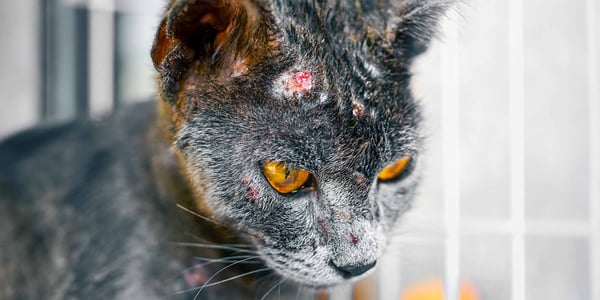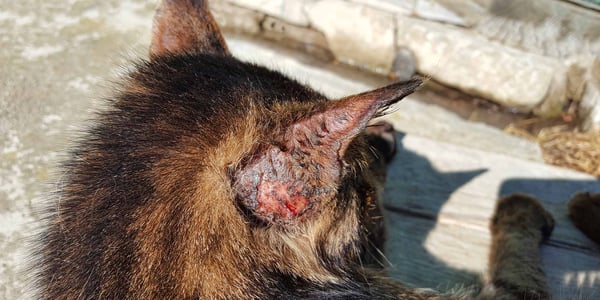Ringworm in Cats - Treatments and Symptoms
Index:



Introduction
Noticed some strange symptoms in your feline friend recently? This could be a sign of ringworm. Don’t panic - whilst ringworm is a serious condition, it is treatable meaning your cat will be on the road to recovery in no time.
Ringworm is a skin disorder and actually has nothing to do with worms - surprise! It’s a fungal infection that produces rings on the skin of the infected cat, hence the name. It can also transfer from animal to human so it’s best to be aware of the signs and symptoms of ringworm in cats as well treatment methods.
Fear not as we’re here to break it all down. Ready? Let’s begin.
What is ringworm in cats?



Though it’s widely known as ringworm, the medical name is feline dermatophytosis. Feline ringworm is a fungal infection that can not only affect a cat’s skin but also their hair and nails. The fungus feeds on keratin and produces more spores - leaving scaly little rings which are more noticeable in humans and less so in cats.
Keratin is a protein that helps to form strong hair, skin, and nails. Without it, cats experience hair loss, itchy skin, and weak nails. Ringworm can be a bit more difficult to recognise in cats due to all their fluffiness. Instead, you’re more likely to notice hair loss or patches of scales instead of typical rings on the skin.
Though if you have a slinky Sphynx cat, ringworm will be more recognisable and easy to see.
Ringworm can be caused by different types of fungus. Some are limited to one species, for example, meaning they can only be transferred from cat to cat whereas others can transfer from cat to dog as well as to humans. Ringworm can be very unpleasant for all but rest assured it can be treated!
There are lots of things to look out for if you think your cat may have ringworm. Becoming familiar with the signs and symptoms will help you identify the condition as quickly as possible, saving your cat any misery and unnecessary trips to the Big Scary Vet.
What does ringworm in cats look like?



Although feline ringworm is treatable, it is highly contagious and can quickly develop leaving your moggy in a bit of a pickle.
Ringworm can appear anywhere on a cat’s body though is typically found on the head, chest, forelegs, and back. Claws can also become infected and develop scales which, if left untreated, can lead to irreversible damage.
The lesions produced by ringworm are usually red in appearance though can appear darker. If your cat is extra fluffy, you may need to grab a torch (away from their eyes, obvs) and take a look to see what’s going on.
Infected animals have a ringworm rash that will usually be very dry and flaky so it’s important to remain sympathetic to your kitty at all times and treat the nasty itchies as soon as possible.
Ringworm in cats symptoms



Noticed your cat itchin’ and scratchin’ more than usual? This could be a sign of ringworm.
Below, we have compiled a list of ringworm in cats symptoms so you can recognise the early signs of infection:
Circular patches of hair loss
Broken or stubbly patches of hair
Crusty or scaly skin
Changes in hair colour
Inflamed skin
Excessive licking and grooming
Dandruff
Infected, scaly claws
So if you notice your poor little fluff ball has patches of skin, broken skin, or any of the above symptoms, it's best to take them to the vet for a diagnosis and to start a treatment plan.
How is ringworm transmitted?
Ringworm fungus is a sneaky little transmitter, passing directly from cat to cat or cat to human through touch. Because cats and dogs tend to be fluffy (and very cute) we’re more likely to pick them up and hold them close, without feeling the scales and knowing they’re infected.
Surfaces and objects can also become contaminated with fungal spores - think toys, bedding, food bowls or anywhere your cat particularly likes to lay, including your kitchen worktop (this tends to be a fav spot amongst cats).
These spores can lay dormant in carpets, combs, and furniture for up to 18 months! It’s also important to note that direct contact with ringworm fungus doesn’t always cause an infection, though it’s better to err on the side of caution and make sure to regularly clean bedding and furniture to reduce the chances of contraction.
Long-haired cats such as the Ragdoll and Maine Coon can carry ringworm with little to no signs of infection and can continue to infect other animals and humans. So just because you may not notice any symptoms, it’s always important to check your kitty for any signs of infection or illness, especially if they like to roam around outdoors.
Can I still cuddle my cat if they have ringworm?
Whilst it can be incredibly difficult not to, you probably shouldn’t pet your cat if they have ringworm. Whilst some species of ringworm can only be transferred between certain animals, some are zoonotic meaning they can infect humans.
To make the situation as stress-free as possible, we recommend swapping your cuddle buddy for a plushie or non-infected pet. However, this is all temporary so you’ll be back to watching your favourite shows together in no time!
How is ringworm in cats treated?
Treatment for ringworm can be easily obtained from your local vet, especially if the infection has been caught early on.
Some vets diagnose feline ringworm by using a special lamp called a Wood’s lamp. This lamp is ultraviolet and will make any areas of ringworm infection glow - during this procedure, your cat may look magical or like they have special superpowers.
However, this doesn’t work for all cases of ringworm so other tests are conducted including fungus samples that are then taken to a laboratory to be tested. In order to do this, a sample of your cat's skin, hair, or nails will be taken.
Just because your cat may be suffering from hair loss, it doesn’t necessarily mean they have ringworm. Other diseases and conditions can cause hair loss, so it is important to take your cat to a vet for the correct diagnosis and treatment.
Once correctly diagnosed, your vet will typically prescribe topical medications, ointments, or shampoo to use in combination with antifungal medication.
Your vet may also recommend a combination of creams and oral medication. You will also be advised to thoroughly clean your home environment to rid yourself and your kitty of any possible re-infection.
Note that the common treatments available may vary on a case-by-case basis.
If you own more than one pet, it is important to try and keep them separated if possible. Your vet may also advise you to treat all pets and not to stop treatment unless you are told to as this can cause the fungus to spread again. Ugh.
The treatment for ringworm in cats can help to prevent any further infection and keep your cat as safe as possible. Just be sure to follow all recommendations , especially administering any treatments for the full period of time suggested. This to help heal and stop the spread of ringworm in your home.



How long is ringworm contagious?



Infected kitties tend to be contagious for around three weeks once treatment begins.
If treatment is not fully prioritised or is stopped before advised, the ringworm will remain contagious for longer and can present more risks to you and your cat, as well as any other pets in your household - something we can assure you don’t want!
It’s also important to not only treat your pet but provide them with fresh bedding, clean water, squeaky clean food bowls, and clean toys. Though you may think these things look clean, they can hold the pesky little spores for a loooong time.
Whilst some people leave ringworm in cats to resolve on its own, this can take up to five months (or longer!) and cause infection in other pets and humans. Therefore, we recommend being smart and sensible by seeking veterinary care as soon as possible.
What's the risk of ringworm to humans?



As mentioned above, ringworm can easily be transmitted to humans - especially children. To minimise this risk we recommend keeping children away from any infected pets and using gloves to administer treatment when possible. This is because ringworm can be transferred by direct skin-to-skin contact, as we'll explain.
Although this can all be a bit tricky - remaining vigilant will mean that you can wave goodbye to ringworm sooner rather than later.
Technically, you cannot catch ringworm if your skin is unbroken. However, the chances of having one hundred per cent unbroken skin are pretty low meaning a scratch, graze, or other skin condition such as eczema could make you vulnerable to catching ringworm from your feline friend.
Ringworm in cats is also more likely to affect those with weakened immune systems and who find it difficult to fight off infection. So whilst you might not think ringworm is a big deal - it totally can be for someone else or their pet.
This means it’s important to remain responsible and seek medical advice as soon as you notice any signs of ringworm in either your cat or yourself.
Conclusion
To conclude, ringworm in cats is a nasty infection that causes itchy skin, hair loss and irreversible damage to your beloved bestie if you don't get effective treatment. It’s not a worm but just named so due to the circle-like rash it creates on the skin of those who are infected.
If you notice your cat is grooming themselves excessively, losing hair, or has developed scales on their nails, head, back, or forelegs, it is worth seeking medical advice and minimising the risk of further contagion.
Cats can pass ringworm onto cats and other animals as well as humans so keeping your home clean and infected cats away from others will stop spores from travelling.
Ringworm treatment will likely include topical therapy such as ointment or cream, as well as tablets to stop itching and further bacterial spread. Antifungal medicine is usually the main treatment and again these can include oral therapy or even an antifungal shampoo.
The main takeaway is not to worry. You don't need aggressive treatments and cats with ringworm can start healing within a few weeks once the diagnosis of ringworm is confirmed and treatment has started.
Waggel Pet Insurance
Need more help? You're in luck if you're a Waggel Pet Insurance member. Along with our excellent coverage, we offer access to a 24/7 online vet to answer all your sticky questions, especially if you need grooming assistance.
Not a member? Why not get a quote now and cover your furry friend for a range of illnesses, all while enjoying our amazing perks and rewards.
Want more like this?
Get updates from us with helpful info, advice, answers to frequently asked questions and much more.
Index:
Related posts:
Get your quote
Along with our excellent coverage, we offer access to a 24/7 online vet to answer all your sticky questions.





